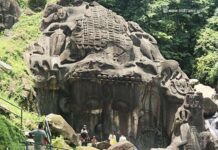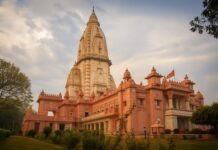Kailasanathar Temple in Kanchipuram was the third big temple I visited after the Kanchi Kamakshi Temple and Ekambareswar Temple. Both the earlier temples were so full of Shakti or the devotional energy that I was still wrapped in that when my auto stopped in front of Kailasnathar temple. An array of bronze Murtis stacked on a pushcart in front of the temple welcomed me.

Now, this is a temple that scholars love. They have written a lot on this temple, interpreting every sculpture on its walls. They have built so much aura around it that I was all excited to visit this temple. However, I found it a rather small and stand-alone temple compared to the other temples. I was the only visitor on a September Morning at the temple. I had it all to myself.

It is breathtakingly beautiful and stunning, to say the least. The clear blue skies added their own brilliance to the sculpted walls.
Meditation Caves or Shrines at Kailasanathar Temple
I had read about and even seen images of the meditation caves at Kailasanathar Temple in Kanchipuram. However, I did not expect a row of 8 of them in front of the temple, almost like a screen standing to shield the temple. In fact, these 8 caves in front of the main temple are 8 shrines with a Shivalinga installed in them.

The main door through the Gopuram asymmetrically stands between these cave shrines, 2 on one side and six on the other. The architecture is unique, no wonder students of architecture and art history find it intriguing. The round pillars with bottoms carved in the shape of mythical animal lions are the signature stamp of the Pallava dynasty.

All around the temple wall called the Prakara, that goes around the temple, there are small meditation caves. Or, are they really the smaller shrines surrounding the main shrine? They are just big enough to allow just one person to sit. There is no space to move or look around. The walls facing the meditation caves are sculpted and painted with mostly Shiva-Parvati sculptures with occasional Ganesha sculptures. Sculptures have managed to stay in some shape. Paintings can be only imagined from what remains in a few of them.

There are 50 of them surrounding the main temple. One can only wonder what was their purpose, and how did the temple look when they all were worshipped.
Kailasanathar Temple, Oldest of Shiva Temple in Kanchipuram
I entered the temple after passing the initial 8 shrines. I found myself standing in front of a wooden blue door with two giant Shiva sculptures on either side. They stand out for their size as well as their white color. They are facing each other but looking the other way. At their feet are again the Pallava lions that you see everywhere in Kanchipuram. The temple Shikhara was still not visible.

One naturally walks towards the left, as if ready to do the parikrama or circumambulation. I walked with a series of meditation caves on my left, each raising my curiosity. After a few steps, the main temple and its lovely Shikhara made an appearance. My eyes and my senses struggled between the two sides of the corridors. On one side was this unique piece of architecture, the smallest possible stone caves, on the other another lovely example of Pallava architecture. Sculptures on every visible part of the walls are enchanting and captivating.

Pillared Mandapa
A pillared mandapa stands in front of the main temple. It is closed as of now. This was the independent mandapa of the temple that was later joined with the main temple by building an Ardh-Mandapa between them. When you stand there, you can sense some disproportionality. I tried to visualize how the temple would have looked without those plain walls connecting the mandapa and the sanctum. The answer is a lot more balanced and proportionate.

Little ahead, there is a side entrance to the temple. A lone priest manages the temple. Compared to the army of priests that I had seen at Ekambareshwar Temple who were busy running around, he seemed to be waiting for devotees. Having said that it does not mean he was polite or had any less air about his priest status.
Sanctum of the Kailasanathar Temple
Inside the sanctum, the temple is rather simpler. There is a 16-faced Shivalinga in black granite. Behind the Shivalinga is an image of Somaskanda that is Shiva, Uma with Skanda or Kartik. This is something I have seen only in the temples of Kanchipuram.

A very narrow parikrama path goes around the sanctum. It is so narrow that I did not dare to go around, feeling claustrophobic. I wonder what was the reason to build such a narrow circum-ambulatory path. In fact, it is not even a straight path, you need to climb a flight of stairs and then crawl down on the other side to do the parikrama and repeat the same at the exit. I was not comfortable for some reason so skipped it. The priest did suggest I do it anti-clockwise, which was a bit simpler, but the Hindu in me disagreed this time.
Later I read that it has a philosophical meaning like going through a re-birth. I am not sure. It sounds more like a strategic escape route that most kings would build for themselves.
Read More – Ekambareshwarar Temple Kanchipuram
Pyramidal Shikhara
This temple has a pyramidal Shikhara, with sculpted figures on each later. It looks like the stone plates are delicately balanced on each other while holding the stories they must tell. On the top is a spherical dome-like finish, almost like a cherry on the cake. The Nandis sit in all four directions on the layer just below the top.

No matter where you stand, you can not miss the series of lion base pillars. If you stand in the corner facing the temple, it would feel like you are in the sanctuary of lions.
You can see every conceivable form of Shiva on the walls. There is one shrine behind the main temple’s back wall that is dedicated to Kartikeyan. Here you can see his Vigraha in black stone. There is a lovely Durga sculpture and Saptamatrikas.
The Kailasanathar Temple Complex
This temple is a stand-alone single temple with no other temple in its complex. As you know, in Kanchipuram Shiva Temples do not have the Devi temple inside them, as is the norm in Shiva temples across India. In Kanchipuram, Devi lives in her own abode only.
Read More – Sri Kanchi Kamakshi Amman Temple
I saw a few Nandi figures behind the back wall of the temple facing the meditation caves. I assume they are for the Shiva Vigrahas in the caves.

Nandi Mandap
The main Nandi Mandap is about 100 meters away across the sprawling lawns from the temple. The Nandi is mid-sized and faces the sanctum, although there are distance and multiple layers of stone that separate the Linga and the Nandi. Four independent pillars stand on the mandap, but it all looks patched up. I wonder if the Nandi Mandap was always located so far or if it has been moved away during some conservation effort.
When you walk on the lawns away from the temple, that is when you see the lions coming out of the outer wall at regular intervals. I wonder if they were also free-standing pillars once and got plastered together later on. The Shikharas of smaller shrines or meditation caves are visible from the outside like a miniature version of the bigger one. Nandis sit in between them on the wall, as they do in every Shiva temple in Kanchipuram.

A tank is located diagonally across the temple at the other end of the lawns.
History and Architecture of the temple
The temple in stone dates back to the late 7th CE and is attributed to Pallava king Narsimhavarman II. The façade that seems to be built later was added by his son Mahendravarman II. It is believed that Rajaraja Chola who built the mighty Brihdeeswara temple in Thanjavur, was inspired by this temple.

The base of the temple is made of hard granite stone while most of the superstructure is in softer sandstone. The main shrine is almost rectangular as is its pyramidical shikhara. The meditation caves or the shrines surrounding the temple are a unique feature of this temple that I am yet to see elsewhere. They do remind me of the meditation caves at 84 Kutiya in Rishikesh.
It is probably a royal temple, built by the royal family, probably for their private Sadhna. It is now under ASI and they maintain this temple. The absence of devotees makes it like a relic of the past even though it is pretty much a practicing and living temple. I am told it is full of people on Shivratri as most Shiva Temples are.
What makes this important is the fact that this may be the first standalone stone temple in the region. Temples earlier to this were built by carving out the rocks in situ or what we know as cave temples. Many of these can be seen at Mahabalipuram nearby.
Travel Tips

- You can take an Auto from anywhere in the city to reach the temple, located in Shiva Kanchi
- Temple is open from 6 AM -12 PM and then 4 PM-9 PM.
- You need at least 30 mins to see the temple properly.
- It is a very photogenic temple. Thankfully photography is permitted, except inside the sanctum. Morning is a better time to go for photography.
- Kanchi Kudil, an old heritage house converted into a museum is close by. You can easily visit it when you visit the Temple.














Your information is very helpful, it provides a lot of help.
wow! it was really amazing. The pictures were amazing. It takes to reality. The sculptures were really wonderful.It was really a amazing sculpture.Temple was full of sculptures no words to describe about those sculptures. Really wonderful.Thank you very much for the post
Nice article of Kailasanathar Temple which is in Kanchipuram. Wonderful helping to visit a lord place.
Very nice article about Shiv ji and Parvati ji thanks for sharing.
Usually, Temple build first and deity brought in later but here, temple is build around the lingam. Lingam was there first and pallava kings build temple around the lingam. It reminds me the Pyramid and pallavas trying to reveal something through this temple and its circumambulation passage but which i dont understand as common man. Egyptian pryamind also contains passage inside and preserves bodies here also this passage relates to death and re-birth. Not there some connections?